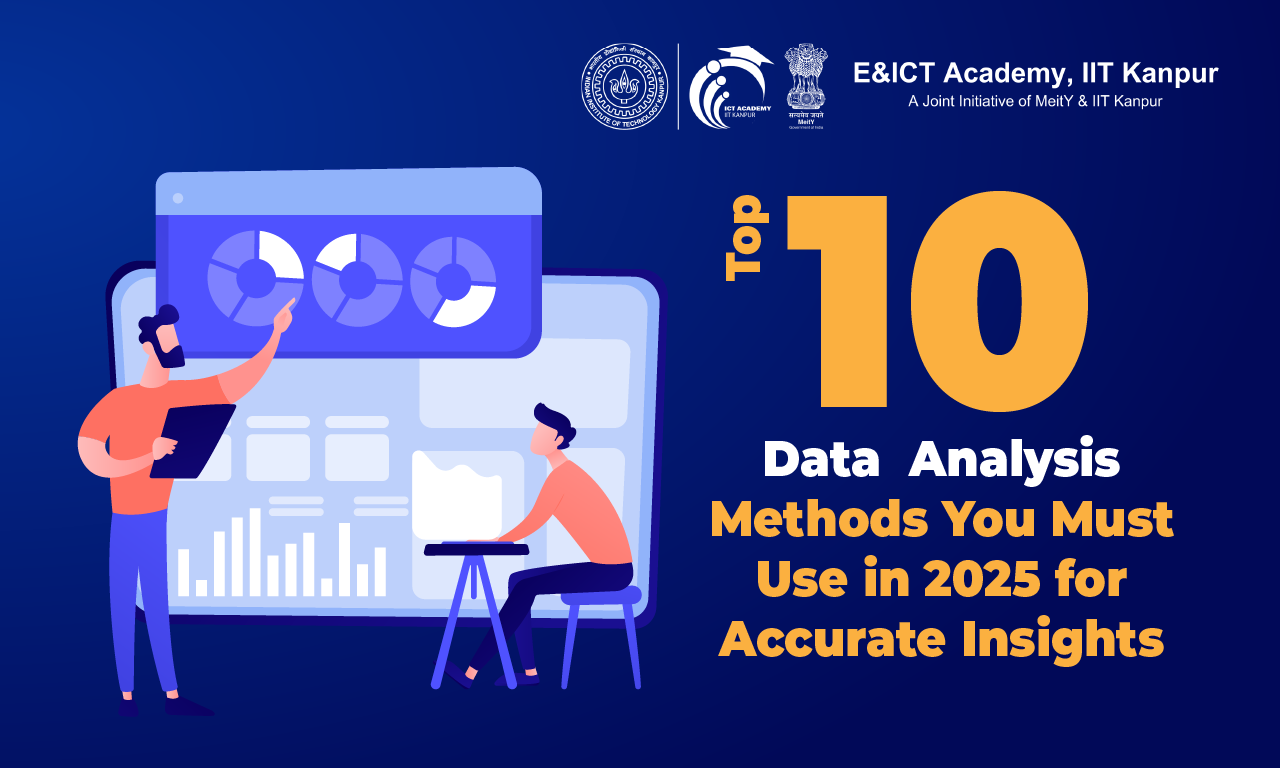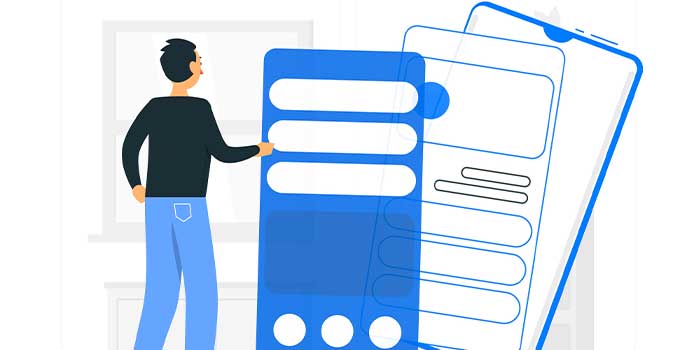Top 10 Data Analysis Methods You Must Use in 2025 for Accurate Insights

Data Analysis Methods
Data is everywhere. Every action we take, from daily purchases to web clicks, produces useful information. However, raw data is just text, figures, or logs and has no meaning on its own.
Data analytics turns that raw data into insightful knowledge, whether you’re a marketer optimizing campaigns, a healthcare expert forecasting patient outcomes, or a business leader looking to increase sales. It is defined as the act of examining unprocessed data to identify patterns and provide answers. This process encompasses a wide range of methods and objectives that vary depending on the industry.
Using the appropriate data analysis techniques has never been more crucial as automation, AI, and machine learning shape the future.
Best Data Analysis Course You Must Explore
In today’s data-driven world, mastering data analysis is the key to unlocking high-paying career opportunities. EICTA, IIT Kanpur brings you the best Data Analysis course, equipping you with the skills to interpret complex data, make informed decisions, and drive business success. Whether you’re looking to upskill or start a new career, this course opens doors to endless possibilities.
Professional Certificate Course in Data Analytics and Generative AI: Enroll Today
Advanced Certification in Data Analytics (Live Online): Enroll Today
Predictive Business Analytics for Decision Making: Enroll Today
Top 10 Data Analysis Methods in 2025
1. Descriptive Analytics
The basis of data analysis is descriptive analytics, which summarizes previous data to help businesses understand prior performance.
- Generates summaries, averages, percentages, and visual insights from raw data.
- Includes tools such as interactive charts, reports, and dashboards.
- Trends in website traffic, revenue growth, and customer retention rates are examples of common KPIs.
Tools Used:
- Excel: Pivot tables, charts, and summary functions.
- Tableau and Power BI: Automatic reporting and interactive dashboards.
- Python: Data manipulation and visualization (Pandas, Matplotlib, Seaborn).
Real-World Application:
Descriptive analytics can help a retail business identify low-performing products and peak sales periods by tracking monthly sales trends.
2. Diagnostic Analytics
Finding the cause of an event requires diagnostic analytics, which goes beyond descriptive insights. It finds correlations, abnormalities, and contributing elements.
- It employs methods such as correlation research, drill-down analysis, and root cause analysis.
- Examines changes in customer behavior or corporate performance.
- Find important affecting elements by comparing some variables.
Real-World Application:
A supermarket analyzes sales data to predict why it has fewer sales compared to last year.
3. Predictive Analytics
The process of forecasting future events using data is known as predictive analytics. The procedure looks for trends that could indicate future behavior using statistical models, machine learning, artificial intelligence, and data analysis
- Finds patterns using statistical methods.
- Uses neural networks, decision trees, and regression models to make predictions.
- Frequently employed in risk assessment, demand forecasting, and sales forecasting.
Must Read: What is Predictive Analytics
Real-World Application:
Marketing campaigns can be targeted using predictive analysis based on consumer information, including past purchases and customer service interactions.
4. Prescriptive Analytics
Prescriptive analytics is a data analytics method that suggests the optimal course of action by utilizing machine learning and statistical algorithms.
- Employs AI-powered algorithms to assess various situations.
- Takes corporate objectives, inventories, and budgetary restrictions into account.
- Provide practical suggestions rather than merely insights.
Common Use Cases:
- Supply chain optimization determines the ideal inventory levels.
- Personalized marketing is the practice of recommending particular products.
Real-World Application:
Prescriptive analytics can benefit businesses in a variety of areas, including retail, finance, and healthcare. It can reduce costs, increase productivity, and improve the customer experience.
Also Read: What You Need to Become Successful Data Analyst?
5. Exploratory Data Analysis (EDA)
Exploratory Data Analysis (EDA) is the process of evaluating data to identify patterns, outliers, and correlations between variables.
- Finds abnormalities and missing values.
- Makes data clusters, linkages, and distributions visible.
- Makes use of techniques such as heat maps, scatter plots, and histograms.
Techniques Used:
- Box Plots & Histograms: Understanding data distributions.
- Correlation Heatmaps: Identifying relationships between variables.
- Scatter Plots: Detecting trends and outliers.
Real-World Application:
Data scientists use EDA to clean data and find important variables influencing predictions before creating a machine learning model.
6. Sentiment Analysis
Sentiment analysis is the technique of determining if a digital text’s emotional tone is positive, negative, or neutral.
- Examine reviews, customer reviews, and social media material.
- Sorts sentiment into three categories: neutral, negative, and positive.
- Detects intent, sarcasm, and context using AI models.
Tools & Libraries:
- Python (NLTK, VADER, TextBlob): Sentiment scoring.
- Google Cloud NLP: Enterprise-level text analysis.
Real-World Application:
Businesses monitor sentiment on social media to assess client satisfaction and modify their marketing tactics as necessary.
7. Cluster Analysis (Segmentation)
Cluster analysis creates client segments by grouping related data sets to reveal hidden patterns.
- Classified Data using unsupervised learning methods.
- Determines client categories for tailored advertising.
Real-World Application:
Banks divide their clientele into risk categories using clustering and then modify loan offers appropriately.
Also Read: Top Data Analysis Skills
8. Time Series Analysis
A statistical technique called time series analysis examines data points gathered over an extended period to spot trends and patterns.
- Models long-term motions, cyclic tendencies, and seasonality.
- Employs certain statistical methods to make predictions.
Real-World Application:
Experts in the stock market use time series analysis to forecast stock values based on historical trends.
9. Anomaly Detection
Finding patterns or occurrences that deviate greatly from expectations is known as anomaly detection.
Identifies data points that substantially depart from typical behavior. Employs computer learning to stop cyberattacks and automate fraud detection.
Real-World Application:
We can use Anomaly detection in credit card firms to instantly identify fraudulent transactions.
10. Association Rule Learning
Market basket analysis makes extensive use of association rule learning, which uncovers hidden correlations between variables.
- Uses if-then rules to find patterns in big datasets.
- Identifies products that are commonly purchased together in transactions.
Real-World Application:
Retailers often suggest related products to customers using association rule learning (e.g., “Customers who bought a phone also bought a phone case”).
| Data Analyst Related Articles | |
|---|---|
| Best Data Analysis Course | Data Analysis Techniques |
| Data Analyst Skills | What is Predictive Analytics |
| Python Interview Questions | Excel Formula for Data Analytics |
Conclusion
Finding hidden insights for wise decision-making requires the use of data analytics tools and approaches. As a result, picking the appropriate ones enables you to attain your business objectives and optimize the value of your data.
Whether you’re learning the ropes or just starting with data, structured learning can be beneficial. Join IIT Kanpur’s Data Analytics programs to learn Python, SQL, and machine learning.
Those who can turn data into insights will be at the forefront of industry leadership, so stay ahead of the curve and never stop learning.



